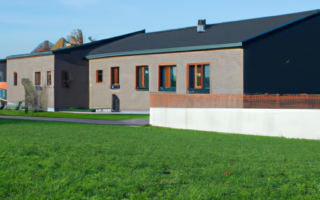Types of Roofing Materials for Commercial Buildings
Choosing the right roofing materials for commercial buildings is crucial for ensuring the longevity and functionality of the roof. The type of material used can greatly impact the building’s energy efficiency, durability, and overall aesthetic appeal. With a wide range of options available in the market, it can be overwhelming to make the right decision. In this comprehensive guide, we will explore the different types of roofing materials suitable for commercial buildings and provide insights to help you select the best option for your specific needs.
1. Single-Ply Membrane Roofing:
One of the most popular choices for commercial roofing is single-ply membrane roofing. This type of roofing material is lightweight, flexible, and easy to install. It offers excellent resistance against ultraviolet (UV) rays, chemicals, and weathering. Single-ply membranes are available in two main types: thermoplastic olefin (TPO) and ethylene propylene diene terpolymer (EPDM). TPO membranes are highly reflective and energy-efficient, while EPDM membranes are known for their exceptional durability.
2. Metal Roofing:
Metal roofing is known for its longevity and durability, making it a preferred choice for commercial buildings. Metal roofs can withstand extreme weather conditions, including high winds, heavy rain, and snow. They are also fire-resistant and require minimal maintenance. Common metal roofing materials include steel, aluminum, and copper. Steel is cost-effective and offers great strength, while aluminum is corrosion-resistant and lightweight. Copper, although expensive, provides an attractive appearance and remarkable durability.
3. Built-Up Roofing (BUR):
Built-up roofing (BUR) consists of multiple layers of bitumen and reinforcing fabrics. This roofing system offers excellent protection against water, UV rays, and extreme temperatures. BUR is known for its long lifespan and ability to withstand foot traffic. It requires professional installation and periodic maintenance to ensure its effectiveness. The primary drawback of BUR is its weight, which may require additional structural support.
4. Modified Bitumen Roofing:
Modified bitumen roofing is a durable and cost-effective solution often used for commercial buildings. This roofing material combines the advantages of built-up roofing (BUR) and single-ply membranes. It is made from asphalt and reinforced with modifiers to enhance its performance. Modified bitumen roofing offers excellent flexibility, weather resistance, and elongation capabilities. It is available in two main types: SBS (styrene-butadiene-styrene) and APP (atactic polypropylene).
5. Green Roofing:
Green roofing, also known as living roofs, is a sustainable option gaining popularity in commercial buildings. It involves the installation of vegetation and a waterproofing system on the roof surface. Green roofs provide numerous benefits, including improved energy efficiency, stormwater management, and ecological impact. They also offer aesthetic appeal and can create a pleasant outdoor space for building occupants.
Choosing the right roofing material for a commercial building requires careful consideration of factors such as budget, durability, energy efficiency, and maintenance requirements. Consulting with a professional roofing contractor can provide valuable insights and help you make an informed decision. By selecting the appropriate roofing material, you can ensure the longevity and functionality of your commercial building’s roof while meeting your specific needs and preferences.
Factors to Consider When Selecting Materials for Commercial Roofing
Choosing the right materials for commercial roofing is a crucial decision that can greatly impact the durability and longevity of a building. With numerous options available, it is important to consider several factors before making a final selection. This comprehensive guide aims to highlight the key factors that should be taken into account when choosing materials for commercial roofing.
One of the primary factors to consider is the climate and weather conditions in the area where the building is located. Different roofing materials have varying resistance to extreme temperatures, heavy rainfall, snow, and wind. For instance, in regions with high levels of rainfall, materials with excellent water resistance such as metal or synthetic membranes may be more suitable. On the other hand, in areas prone to extreme heat, cool roofing materials like reflective coatings or shingles can help to reduce energy consumption and minimize heat absorption.
Another important aspect to consider is the slope or pitch of the roof. Some materials are better suited for flat or low-sloped roofs, while others are designed for steeper pitches. For example, flat roofs often require materials with superior waterproofing capabilities, such as built-up roofing (BUR) or single-ply membranes. Conversely, materials like asphalt shingles or metal roofing are commonly used on roofs with steeper slopes.
The intended use of the building is also a crucial factor to consider. Certain materials may be more suitable for specific commercial purposes than others. For instance, if the building is used for heavy industrial activities, materials with high resistance to chemicals, impacts, and fire may be required. On the other hand, if the building houses a retail establishment, aesthetics and visual appeal may be more important, making materials like architectural shingles or clay tiles a popular choice.
The budget allocated for the roofing project is another key consideration. Different materials come with varying costs, making it essential to find a balance between quality and affordability. While it may be tempting to opt for cheaper materials, it is important to assess their long-term costs as well. Some low-cost materials may require frequent repairs or replacements, ultimately leading to higher expenses over time. Consulting with roofing professionals and obtaining multiple quotes can help to determine the most cost-effective option.
Lastly, it is crucial to consider the maintenance requirements and lifespan of the selected materials. Some materials may require regular inspections, cleaning, and maintenance to ensure their optimal performance and longevity. Others may be more durable and require minimal upkeep. Understanding the maintenance needs and lifespan of the materials is essential for proper budgeting and planning.
In conclusion, choosing the right materials for commercial roofing requires careful consideration of various factors. Climate conditions, roof slope, intended use of the building, budget, and maintenance requirements all play a significant role in determining the most suitable materials. By thoroughly evaluating these factors, building owners can ensure they make an informed decision that enhances the durability and performance of their commercial roof.



